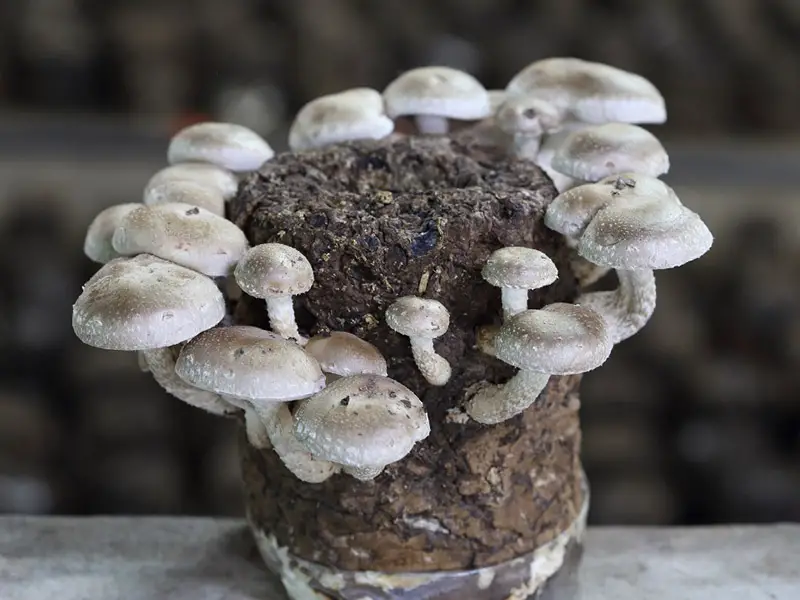If you are one to enjoy a cup of coffee each day, then you might be looking for a way to give those spent grounds another use instead of sending them to a landfill. You may have heard of some using coffee grounds to grow shiitake mushrooms. But does it actually work?
Coffee grounds are a great substrate for various types of mushrooms, including shiitake mushrooms. Spent coffee grounds are packed full of the nutrients that mushrooms need to grow, and, when added in the right amount, can improve results.

If you’ve never done it before, growing shiitake mushrooms can seem a bit strange—even to a seasoned gardener. But learning how to grow and harvest your own mushrooms is highly rewarding. Keep reading for more information on growing Shiitake mushrooms in coffee grounds.
Can Shiitake Mushrooms Grow in Coffee Grounds?
Like all mushrooms, shiitake mushrooms require organic matter to grow. This is known as the substrate. The substate not only acts as a medium for the mycelium to develop but also provides nutrients to help the mushrooms grow.
The good news is that coffee grounds are rich in many of these nutrients, making them a suitable substrate for growing mushrooms. Some of these nutrients include nitrogen, potassium, calcium, magnesium, boron, copper, iron, and zinc.
The bad news is that coffee grounds are slightly acidic. And while oyster mushrooms don’t seem to have a problem with this, shiitakes are a bit pickier. Instead of using pure coffee grounds as a substrate, shiitake mushrooms prefer a sawdust and coffee ground mixture.
What are the Benefits of Using Coffee Grounds Versus Another Material?
Growing shiitake mushrooms on coffee grounds can be highly beneficial compared to using other materials. Many gardeners use coffee as a compositing ingredient because it can help balance out the soil. But it is also a great substrate for growing shiitake mushrooms.
To start, there is no need to sterilize the material before growing. When growing mushrooms, it is essential to prevent competing fungi, insects, and bacteria from settling in your substrate. When using sawdust or other popular substrates, the material needs to be pasteurized or sterilized to kill off any competing bacteria.
The good thing about using spent coffee grounds to grow shiitakes is that they already go through a pasteurization process, which means you can skip pasteurization.
Coffee grounds are also easily sourced compared to other materials. While shiitake mushrooms are typically found on oak trees in the wild, not everyone has an oak tree in their backyard. Plus, growing on whole logs can be difficult because mushrooms need a sterile environment.
The next best thing is to use hardwood sawdust pellets. While these can be found at many home and garden stores, you’ll find that most of them are not “food safe” or naturally sourced. Whether you’re collecting your own or asking a local café, spent grounds are typically a lot easier to come by than sawdust, straw, or logs.
Using coffee grounds in your substrate isn’t only good for the mushrooms, it’s good for the environment. When you make a cup of coffee, only about 1% of the biomass is actually used. With nearly 60 nations producing coffee and over 5 million metric tons being exported each year, imagine how much of that is being wasted.
By adding grounds to your mushroom substrate mixture, you are giving them a second use and creating a more sustainable practice.
How To Prepare the Coffee Grounds to Grow Shiitake Mushrooms
When preparing your substrate, there are a few different methods you could follow. For the most part, you’ll be using a mixture of fresh coffee grounds, some sort of breathable material, and lots of moisture.
It’s important to remember to use coffee grounds that have been brewed no more than 24 hours prior. Coffee that is older can have mold spores forming that are hard to detect. You’ll also want to avoid using coffee grounds straight out of the coffee maker. Instead, let them cool down a bit before using them.
Shiitake mushrooms grow best on a wood-based substrate. Typically, any hardwood sawdust pellets will work well. These can easily be found at local retail stores or online. Just make sure to get hardwood sawdust pellets and not softwood pellets, and to look for pellets that are made with the intention of using them around food.
Preparing Coffee Grounds to Use with Hardwood Sawdust
To prepare your substrate, you’ll first need to get the weight of your coffee grounds. You may also want to buy a mushroom kit that comes with spores or mushroom spawn. So, if you don’t plan on using a log as your substrate, buying a separate mushroom kit is probably best.
Looking for an easy way to grow mushrooms at home? Check out these fun grow kits on Amazon.
Before mixing your sawdust and coffee grounds, make sure to pasteurize your sawdust. This can be done in a large cooking pot with hot water. You will need to submerge the sawdust in hot water for at about 12 hours.
If you are using sawdust pellets meant for growing mushrooms, these will not have to be pasteurized since it is already done during the manufacturing process. However, you do need to soak them in clean water for about 30 minutes to rehydrate them.
The amount of spawn and sawdust you use is going to depend on the amount of coffee you have. You will need 20% of the coffee weight of sawdust and 10% of the coffee weight of shiitake mushroom spawn. Then, simply mix everything together and place it into a large plastic growing bag.
Seal the bag with tape and place it in a clean, non-drafty location. Once the mycelium develops, you can leave the bag open.
Shiitake mushrooms develop best when the temperature stays between 65 – 75 degrees Fahrenheit, so, pick an area where the temperature isn’t fluctuating too much. Mist the mushrooms with water at least twice a day to keep the substrate moist. This step is critical since mushrooms are 80-90% water.
How Long Does It Take to Grow Shiitake Mushrooms in Coffee Grounds?
When it comes to mushrooms, shiitakes are not considered the easiest to grow. For the most part, they aren’t aggressive growers and require a longer incubation period than other mushroom species.
After inoculation, it will take at least a few weeks until you start to see any change. The average time for the mycelium to fully colonize is about two or three months. Once the mycelium is fully colonized, open the bag up and place it in an area with high humidity and access to fresh air.
Once fully colonized, the shiitakes should fruit within 7-10 days. Depending on the size of your growing bag, you may get up to seven flushes of shiitake mushrooms.
How To Harvest and Store Shiitake Mushrooms
When the mushrooms look like they’re beginning to dry out or the gills become visible, it’s time to harvest them. For the most tender and flavorful shiitake mushrooms, harvest them before the cap start to flatten or curl outwards.
To harvest, take a pair of scissors and cut the base of the mushroom stem at the substrate. These can either be eaten fresh or stored for later use. If you plan on eating them soon, immediately refrigerate your mushrooms after harvesting them to extend the shelf life. Using a paper bag to store them is best. Plastic or cling wrap can increase moisture and accelerate decomposition.
To store your mushrooms for the long term, dehydrating them is the best option. This can be done in various ways including laying them out in the sun or using a dehydrator. You could even dry them in your oven by using a low heat setting for 5 – 10 hours.
Final Thoughts
Growing shiitake mushrooms in coffee grounds can be challenging but it is also rewarding. The most important thing is to make sure that your coffee grounds are fresh, and the substrate is pasteurized to avoid contamination. Once you get the hang of growing shiitake mushrooms in coffee grounds, the flushes will be some of the largest of any mushroom species!
